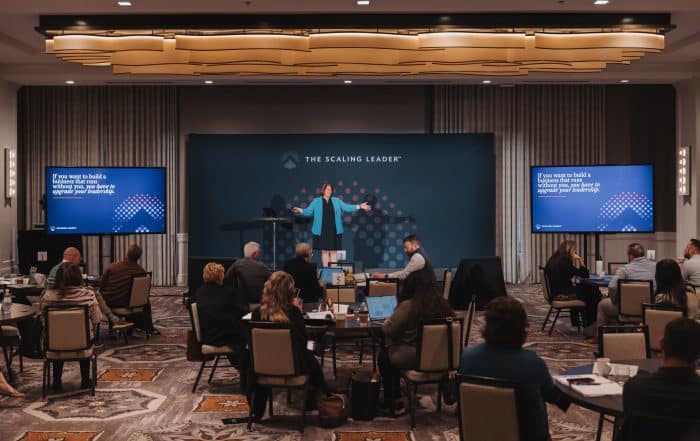Building high-performing teams is crucial for the success and scalability of any organization, and therefore, vital to optimize each team member’s performance. By tapping into their unique strengths, you can unlock your team’s full potential and propel your business towards growth and excellence.
Unleashing the Power of Team Optimization
As a leader, one of your key responsibilities is to optimize the performance of your team. When you’re building a new team or leading a small team, the journey of optimizing their performance often unfolds organically. Psychologist Bruce Tuckman’s Five Stages of Team Development—Forming, Norming, Storming, Performing, and Adjourning—provide valuable insights into this process.
During these stages, the leader develops personal relationships with team members, while they also develop relationships with each other. Challenges are encountered, solutions are collaboratively devised, and different points of view, personal styles, strengths, and abilities come to light. These experiences enable both the leader and the team to tailor the team’s structure, role, interactions, strategies, processes, and policies to align with not only goals and objectives but also the unique strengths and weaknesses of individuals.
However, in many organizations, this valuable information remains undocumented and unknown beyond the immediate team and leader. As an organization grows, the lack of company-wide visibility results in missed opportunities to leverage their most valuable asset—their people. To really boost productivity and build high-performing teams, it’s important to systematically identify and make the most of each team member’s strengths and weaknesses.
Understanding the Five Stages of Team Development
To effectively optimize your team’s performance, it’s crucial to have an understanding of the Five Stages of Team Development as proposed by Bruce Tuckman. Although these stages may occur sequentially, they aren’t always linear and can overlap or reoccur throughout the lifespan of a team.
Recognizing Forming, Norming, Storming, Performing, and Adjourning
- Forming: The first stage, forming, marks the initial coming together of the team. During this stage, team members get acquainted, establish their roles, and set expectations. It’s common to encounter excitement, enthusiasm, and a focus on building positive interpersonal relationships.
- Norming: Next comes the norming stage, where the team starts to find its rhythm and establishes norms, values, and shared goals. Collaboration and communication become smoother as the team begins to trust and rely on one another.
- Storming: The storming stage involves the emergence of conflicts and differences of opinion within the team. This phase presents an opportunity for growth and innovation as various perspectives are brought to the table. Effective leaders understand the importance of managing conflicts constructively during this stage to help the team move forward.
- Performing: Once the storming phase is successfully navigated, the team enters the performing stage. Here, the focus shifts toward achieving the team’s objectives efficiently and effectively. Team members feel a sense of synergy, accountability, and collective achievement.
- Adjourning: Lastly, the adjourning stage occurs when the team completes its tasks and transitions to new projects, departments, or roles. Acknowledging the accomplishments and celebrating the successes of the team during this stage helps cultivate a culture of recognition and gratitude.
By recognizing and understanding each stage, you can navigate your teams’ journeys more effectively, anticipating challenges, fostering collaboration, and capitalizing on the diverse talents present within you organization.
Discovering Individual Strengths
An essential component of optimizing your team’s performance lies in discovering and harnessing the unique strengths of individual team members. By assessing their strengths, personalities, and instinctive actions, you can gain invaluable insights that inform how best to position team members for success.
Assessing Wiring through CliftonStrengths, Enneagram, and Kolbe
One effective approach for identifying individual strengths is through the utilization of assessments such as CliftonStrengths, Enneagram, and Kolbe. These tools provide valuable data regarding your team members’ natural inclinations, preferences, and areas of expertise.
- CliftonStrengths focuses on uncovering individuals’ top strengths among 34 talent themes. Through the assessment, team members can gain self-awareness and understand how to leverage their dominant qualities to contribute meaningfully to the team.
- Enneagram, on the other hand, provides insights into individuals’ personality types based on nine interconnected archetypes. This assessment highlights motivations, fears, and desires, offering you a deeper understanding of team dynamics and possible sources of conflict.
- Kolbe assesses individuals’ instinctive behaviors and problem-solving styles. It helps you understand how team members naturally take action, innovate, handle risks, and work towards their goals. Armed with this knowledge, you can tailor assignments and create environments that amplify the inherent strengths of each team member.
These assessments offer a comprehensive understanding of how team members think, feel, and act, enabling you to match individuals’ skills, aptitudes, and interests to the right roles, projects, and responsibilities.
Customizing Approaches for Optimal Performance
After identifying individual strengths, the next important step is to tailor approaches to boost team performance. This might involve revising key plans and processes, adjusting staffing strategies, and fine-tuning internal communications. By making these strategic changes to match the team’s makeup, you can really unleash their full potential.
Enhancing Essential Plans and Processes
Armed with an awareness of team members’ strengths, you can reimagine key plans and processes to better suit their capabilities. Recalibrating staffing plans, organizational charts, project assignments, and methods for training and recognition ensures optimal alignment between tasks and individual proficiencies.
- Internal communication strategies are also crucial for leveraging strengths. By fostering open communication, encouraging active participation, and providing platforms for sharing ideas and feedback, you promote collaboration, innovation, and continuous improvement.
- Professional development programs should also be tailored to individual learning styles and aspirations. Offering relevant training opportunities, mentorship programs, and skill-building workshops enhances competencies and boosts motivation, engagement, and productivity.
- Conflict resolution and problem-solving processes need to acknowledge and capitalize on the diverse strengths within the team. Encouraging healthy debates, embracing different viewpoints, and using collaborative decision-making techniques lead to better problem-solving and creativity.
By customizing these essential plans and processes, you can create an environment where each team member’s strengths are maximized, fueling overall team performance and achieving tangible results.
Filling Competency Gaps through Leadership Development
Maximizing individual strengths is crucial, but it’s also important to address any skill gaps to ensure the team’s growth and sustained high performance. By implementing effective leadership development programs and tailored professional development plans, you can close these gaps, boosting both team and organizational success.
Creating Individual Professional Development Plans
Leadership development programs are essential for building key managerial skills like effective communication, decision-making, and conflict resolution. By equipping your team leaders with the necessary tools and resources, they can inspire and guide their teams to reach their full potential.
Alongside these broader programs, individual professional development plans help team members create personalized paths for acquiring new skills, expanding their knowledge, and pursuing career advancement. Clear milestones, regular check-ins, and ongoing support from leaders ensure continuous growth and development.
Identifying competency gaps at the individual level and implementing targeted learning interventions serves two main purposes: addressing weaknesses and creating well-rounded team members. This investment in personal growth is shown to boost employee net promoter score, extend average tenure per employee, reduce turnover rates, and increase average profit per person.
Unlocking Human Intelligence for Exceptional Results
Optimizing team performance isn’t just about surface-level improvements; it involves deeply understanding, appreciating, and leveraging individual strengths. By guiding your team through the stages of team development, harnessing their innate wiring, customizing approaches, and filling competency gaps, you pave the way for extraordinary achievements.
When you actively embrace human intelligence—the potent combination of each team member’s strengths, personalities, and natural behaviors—your organization thrives. This untapped potential within individuals transforms into collective power, driving your organization towards unprecedented growth and success.
Key Takeaways
- Understanding the Five Stages of Team Development (Forming, Norming, Storming, Performing, and Adjourning) enables leaders to effectively navigate their team’s journey.
- Assessments such as CliftonStrengths, Enneagram, and Kolbe provide valuable insights into individual strengths and natural inclinations.
- Customizing approaches through enhanced plans, processes, communication strategies, and professional development programs maximizes team performance.
- Leadership development programs and individual professional development plans address competency gaps and nurture comprehensive growth.
- Investing in team optimization and individual growth boosts employee net promoter scores, extends average tenure, reduces turnover rates, and increases average profit per person.
How can you apply the principles discussed in this article to unlock the hidden potential within your own team?
Unlock the true power of your team and drive exceptional results. Embrace the unique strengths of each team member, foster a culture of continuous growth, and elevate your organization to new heights.
If you want to learn more about using CliftonStrengths, Enneagram, and Kolbe to better understand your team, schedule a discovery call to discuss how I can help you leverage your team’s strengths to boost their full potential.
Are you ready to unlock your team’s full potential? Start leveraging individual strengths and watch your organization thrive!
ABOUT THE AUTHOR
Courtney De Ronde
Relevant Posts
Learn What Your Business Needs Most to Unlock Faster Growth
Your business relies on four key areas, or centers of intelligence, to thrive. Take the free Business Intelligence Grader to see how you score across financial, leadership, productivity, and human intelligence and learn where to focus to drive greater results.
Your business relies on four key areas, or centers of intelligence, to thrive. Take the free Business Intelligence Grader to see how you score across financial, leadership, productivity, and human intelligence and learn where to focus to drive greater results.



